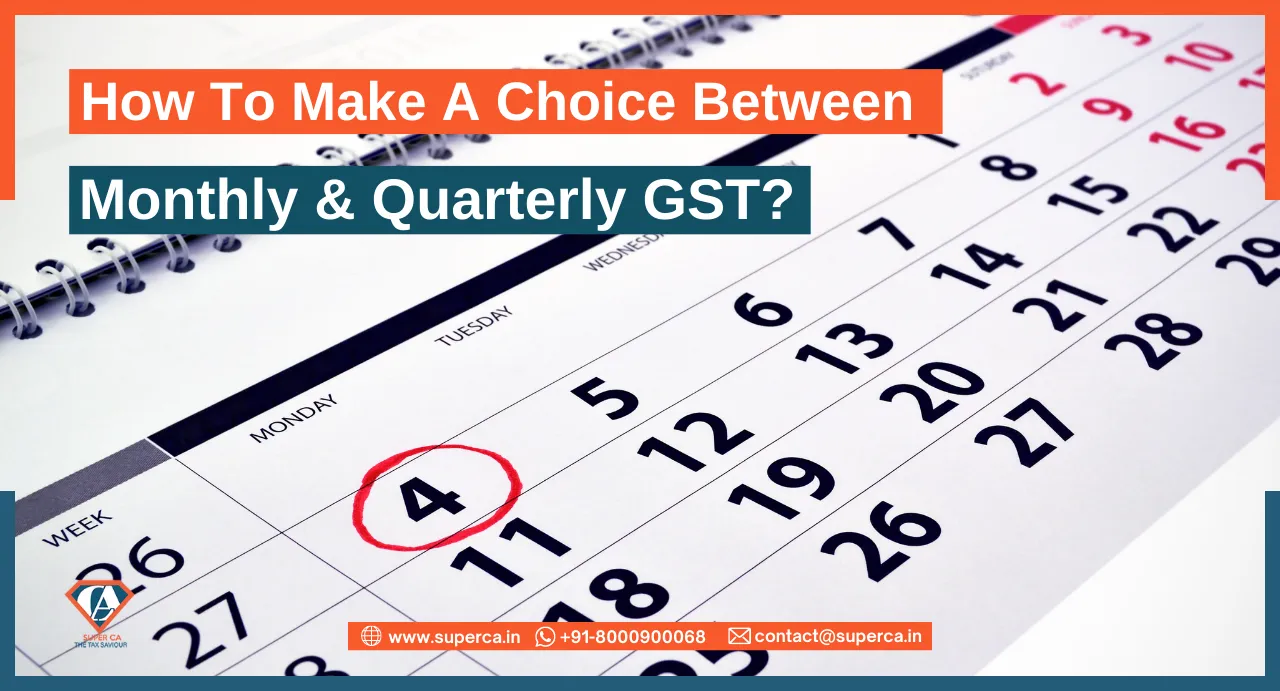How To Make A Choice Between Monthly & Quarterly GST?


Under GST,all registered people have to get their GST return filing done irrespective of the type of business or turnover or profitability during the period. A business or the taxpayer while online GST return filing are required to file the details related to total sales, total purchases and the output GST or the GST paid by the customers etc. accurately.
Furnishing GST Returns timely helps the GST authorities carry out taxpayer’s assessment. These returns are filed to pay taxes as well as to provide data to the government relating to the transactions made by the business during the period under consideration. Once you file GST returns, you will need to pay the resulting tax liability i.e money that you owe the government.
In recent times, due to introduction of QRMP (Quarterly Returns Monthly Payment) scheme, there is confusion in every GST enrolled individual regarding to which scheme they choose for return filing.This article explains comparative analysis of various features of both QRMPs and Monthly GST Return Filing Scheme as well as difference between the two.
In order to reduce tax compliance burden on MSME entities, the QRMP (Quarterly Returns Monthly Payment) was brought into effect from 1st January, 2021. This scheme aimed to provide reduction in compliances and the consumption of the time for preparation and GST furnishing returns for small taxpayers.
The QRMP scheme allows registered taxpayers with an aggregate turnover of up to INR 5 crores in the previous financial year to choose for filing returns on a quarterly basis and make tax payments on a monthly basis using PMT-06.
Previously, taxpayers were required to file GSTR-1 and GSTR-3B monthly, but with the QRMP scheme, they can file returns once a quarter. Once you opt for this scheme, you will continue to be in this scheme unless you cross the turnover threshold or opt out of it.
|
S.No. |
Benchmark |
QRMP |
Monthly Scheme |
|
1 |
Total number of GSTR 1 and 3B filings |
4 |
12 |
|
2 |
Eligibility
|
Taxpayer’s aggregate turnover should be less that INR 5 crores in the previous FY
|
All registered individuals
|
|
3 |
Preparation of HSN Wise Summary, Exempt & NIL rated supplies details, State Wise & Rate Wise unregistered B2C details & documents list of Invoice Numbers & Credit Notes Numbers
|
Quarterly |
Monthly |
|
4 |
Reconciliation of Books with GST Returns filed
|
Slightly complicated
|
Easy to reconcile because of availability on monthly returns filed figures
|
|
5 |
Due date for Monthly Payment of Tax
|
25th for 1st Two Months of Quarter
|
22nd/24th (as applicable for Particular State)
|
|
6 |
Payment of taxes |
Taxpayers must deposit tax in the first two months of a quarter directly using the PMT-6 and make payment while filing GSTR-3B for the last month (3rd month) of the quarter. |
Taxpayers must use the PMT-06 challan for making any GST payment towards the electronic cash ledger, around the time of filing GSTR-3B. The details thereof will appear in GSTR-3B. They also can create a challan and pay towards it either before login or after login or while filing GSTR-3B returns. |
|
7 |
Management of Working Capital
|
Option to choose between Self Assessment Method & Fixed Sum Method monthly, depending upon fund availability.
|
Self Assessed Payment on monthly basis
|
|
8 |
Compliance cost for payment to accountant & tax professional
|
Lower |
Higher |
|
9 |
GST Return filing & compliance burden for Tax Payer
|
Less |
More |
Registered persons opting QRMP scheme would be required to pay the tax due on a monthly basis in each of the first two months of quarter by the 25th of succeeding month using form GST PMT-06.
The taxpayers can pay their monthly tax liability either in the Fixed Sum Method (FSM) or Self-Assessment method (SAM).
You will be able to understand the above statement better by the following examples :
Example 1 - Is GSTR-3B for Jan-March, 2021 was filed on quarterly basis
|
Tax paid in cash during Jan-March, 2021 quarter |
Tax required to be paid in each of April-May, 21 |
|
CGST |
20,000 |
CGST |
7,000 |
|
SGST |
20,000 |
SGST |
7,000 |
|
IGST |
40,000 |
IGST |
14,000 |
|
Cess |
6,000 |
Cess |
2,100 |
Example 2 - If GSTR-3 was filed on a monthly basis for tax period March, 2021.
|
Tax paid in cash in March, 2021 |
|
Tax required to be paid in each of the months April-May, 21 |
||
|
CGST |
1,000 |
|
CGST |
1,000 |
|
SGST |
1,000 |
|
SGST |
1,000 |
|
IGST |
1.600 |
|
IGST |
1,600 |
|
Cess |
- |
|
Cess |
- |
In this method the registered person can pay the tax due by considering the tax liability on inward and outward supplies and the input tax credit available.
Conclusion
Both the schemes stand with their own pros and cons. Thus it is best to understand both the scheme well before opting the relevant one that is preferable to you and your client. But whether you opt for QRMP scheme or monthly scheme, you have to adhere to the statutory compliance and complete all the necessary GST return filing before the due dates. It is important for businesses and entrepreneurs to stay compliant with the authorities.

|
Essential LLP Registration Documents: A Complete Checklist for Entrepreneurs Author: Rahul Singh 04 Apr, 2024
|
Get inspired by these stories.